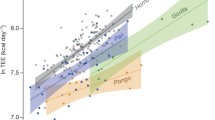Abstract
Human newborns and infants have morphological and physiological traits protecting them against hypothermia. These traits are unusual for primates, with some of them rarely seen in other mammals evolving in an African environment. We can include the following: 1.) A non-allometric, bigger size of the newborn, resulting in the decrease of surface to body mass ratio (S/W). 2.) Greater amount of subcutaneous fat tissue (SFT) increasing insulation. 3.) Greater amount of brown fat tissue increasing nonshivering thermogenesis. 4.) Active thermoregulation when sleeping. 5.) Thermal balance moved in the direction of heat conservation in a few months' old babies.
I here present a hypothesis that it was the risk of nocturnal hypothermia in open habitats of late Pliocene that was the selective pressure promoting evolutionary emergence of these traits inHomo erectus. The inverse radiation at night in open habitats causes strong gradient of temperatures. In effect the temperatures near the ground (even in the tropics) can be low enough to endanger newborns and infants with hypothermia. If earlyHomo was naked, slept on the ground and if mortality of their babies caused by hypothermia was high, then selection pressures could have promoted those traits protecting infants against the risk of hypothermia. Since the most important traits (1. & 2.) in respect of heat conservation, depend on mother size, it is postulated that they appeared when female body size increased dramatically i.e. duringHomo erectus stage of human phylogeny.
Similar content being viewed by others
References
Baker P.T., 1992.Human adaptations to the physical environment. In (S. Jones, R. Martin, and D. Pilbeam, eds.).The Cambridge Encyclopaedia of Human Evolution, pp. 46–51. Cambridge Univ. Press.
Bellomo R.V., 1994.Methods of determining early hominid behavioral activities associated with the controlled use of fire at FxJj 20 Main, Koobi Fora, Kenya. J. hum. Evol., 27: 173–195.
Boyd E., 1935.The surface area of the human body, pp. 113–142, Univ. Minnesota Press, Minnesota.
Bromage T.G. and Schrenk F., 1995.Biogeographic and climatic basis for a narrative of early hominid evolution. J. hum. Evol., 28: 109–114.
Cerling T.E., 1992.Development of grasslands and savannas in East Africa during Neogene. Palaeogeogr. Palaeoclimat. Palaeoecol., 97: 241–247.
Falk D., 1990.Brain evolution in Homo: the “radiator” theory. Behav. Brain Sci., 13: 333–344.
Fiaŀkowski K.R., 1978.Early hominid brain evolution and heat stress: a hypothesis. Studies in Physical Anthropology, 4: 87–92.
Fields S.J. and Frisancho A.R., 1993.Selection on maternal and neonatal size at birth. Human Biology, 65: 579–591.
Fleming P.J., Azaz Y. and Wigfield R., 1992.Development of thermoregulation in infancy: possible implications for SIDS. J. Clinical Pathology, 45: 17–19.
Foley R.A., 1994.Speciation, extinction and climatic change in hominid evolution. J. hum. Evol., 26: 275–289.
Forbes G.B., 1987.Human Body Composition. Growth, Aging, Nutrition, and Activity. Springer-Verlag, New York.
Franciscus R.G. and Trinkaus E., 1988.Nasal morphology and the emergence of Homo erectus. Am. J. phys. Anthrop., 75: 517–527.
Frost G.T., 1987.How did big brains evolve? The role of neonatal body size. Hum. Evol., 2: 193–203.
Goudie A., 1990.Environmental Change. Clarendon Press, Oxford (2nd ed.).
Griffiths J.F., 1972.World Survey of Climatology, vol. 10,Climates of Africa, Elsever Publishing Company, Amsterdam.
Harrison G.A., Tanner J.M., Pilbeam D.R. and Baker P.T., 1989.Human Biology. Oxford Univ. Press, Oxford (3rd ed.).
Harvey P.H., Martin R.D. and Clutton-Brock T.H., 1987.Life Histories in Comparative Perspective. In (B.B. Smuts, D.L. Cheney, R.M. Seyfarth, R.W. Wrangham, and T.T. Struhsaker, eds).Primate societies, pp. 181–196. The University of Chicago Press.
Hey E.N. and Katz G., 1970.The optimum thermal environmental for naked babies. Arch. Dis. Child., 45: 328–334.
Houšlek J., Vizek K., Pavelka S., Kopecký! J., Krejčowá E., Heřmanska J, and Čermakova M., 1993.Type II Jodothyronine 5′-Deiodinase and uncoupling protein in brown adipose tissue of human newborns. Clinical Endocrinology & Metabolism, 77: 382–387.
Johnston F.E., Cohen S. and Beller A., 1985.Body composition and temperature regulation in newborns. J. hum. Evol., 14: 341–345.
Kawashima Y., 1993.Characteristics of the temperature regulation system in the human body. J. of Thermal Biology, 18: 307–323.
Leutenegger W., 1976.Allometry of neonatal size in eutherian mammals. Nature, 263: 229–230.
Leutenegger W., 1982.Encephalization and obstetrics in primates with particular reference to human evolution. In (E. Armstrong and D. Falk eds.) Primate Brain Evolution: Methods and Concepts. pp. 85–95. New York: Plenum Press.
Lynch G., Hechtel S., and Jacobs D., 1983.Neonate size and the evolution of brain size in the anthropoid primates. J. hum. Evol., 12: 519–522.
McArthur A.J. and Ousey J.C., 1994.Heat loss from a wet animal: changes with time in the heat balance of a physical model representing a newborn homeotherm. J. of Thermal Biology, 19: 81–89.
McHenry H.M., 1994.Behavioral ecological implications of early hominid body size. J. hum. Evol., 27: 77–87.
Montagna W., 1985.The evolution of human skin. J. hum. Evol., 14: 3–22.
Oke T.R., 1992.Bound layer climates. Routledge, London (2nd ed.).
Ruff C.B., 1994.Morphological adaptation to climate in modern and fossil Hominids. Yb. Phys. Anthrop., 37, 65–107.
Stelzner J.K., 1988.Thermal effects on movement patterns of yellow baboons. Primates, 29: 91–105.
Stothers J.K. and Warner R.M., 1984.Thermal balance and sleep state in the newborn. Early Human Development, 9: 313–322.
Tobias P.V., 1991.The environmental background of Hominid emergence and the appearence of the genus Homo. Hum. Evol., 6: 129–142.
Tromp S.W., 1980.Biometeorology, Heyden, London.
Turner A., Wood B., 1993.Taxonomic and geographic diversity in robust australopithecines and other African Plio-Pleistocene larger mammals. J. hum. Evol., 24: 147–168.
Wheeler P.E., 1984.The evolution of bipedality and loss of functional body hair in hominids. J. hum. Evol., 13: 91–98.
Wheeler P.E., 1991.The thermoregulatory advantages of homind bipedalizm in open equatorial environments: the contribution of increased convective heat loss and cutaneous evaporative cooling. J. hum. Evol., 21: 107–115.
Wood B., 1992.Origin and evolution of the genus Homo. Nature, 355: 783–790.
Worthington-Roberts B.S., 1989.Maternal nutrition and the outcome of pregnancy. In (B.S. Worthington-Roberts and S.R. Williams, eds.).Nutrition in Pregnancy and Lactation, pp. 47–140. Times Mirror/Mosby College Publishing.
Author information
Authors and Affiliations
Rights and permissions
About this article
Cite this article
Pawŀwski, B. Why are human newborns so big and fat?. Hum. Evol. 13, 65–72 (1998). https://doi.org/10.1007/BF02439370
Accepted:
Issue Date:
DOI: https://doi.org/10.1007/BF02439370




